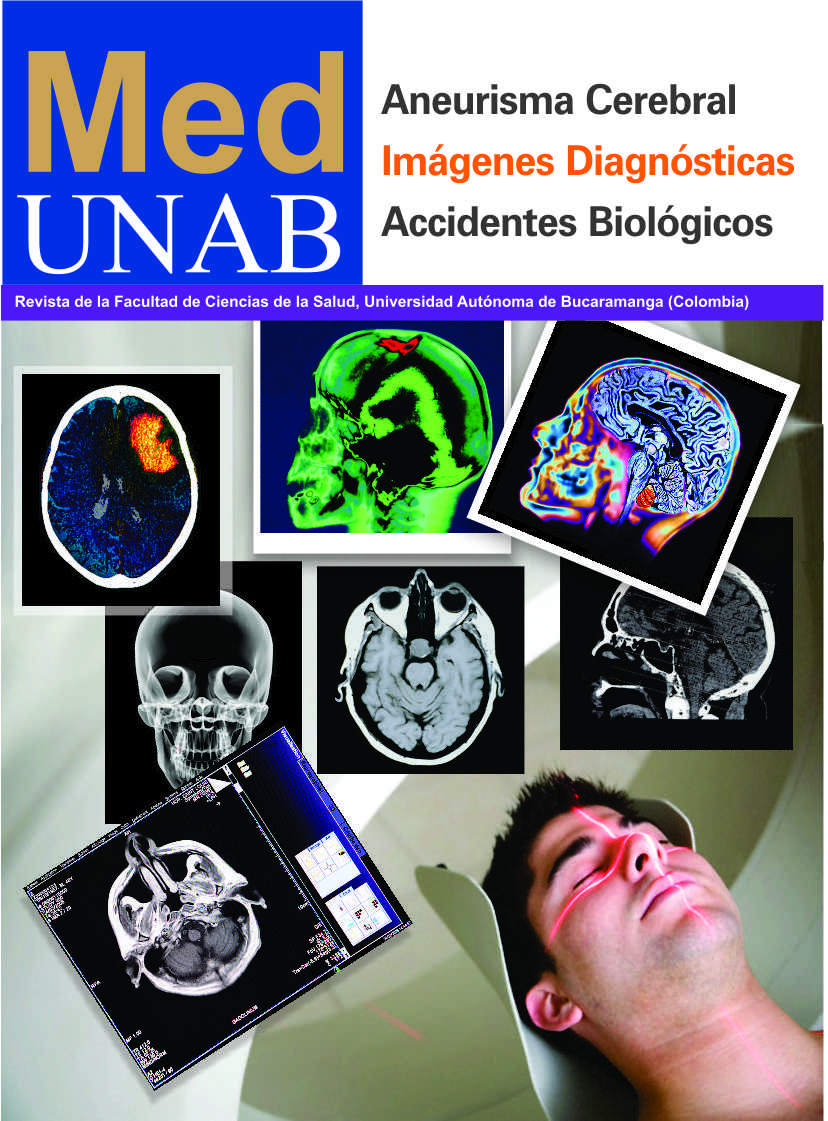Uso de imágenes diagnósticas en trauma raquimedular
Resumen
El trauma de la columna vertebral trae implicaciones serias tanto para la morbimortalidad del paciente como para el sistema de salud, por lo cual es necesario conocer el enfoque diagnóstico por imágenes, ya que este es fundamental para el manejo de los pacientes. Para ello se debe recordar la anatomía, la biomecánica de la columna y entender muy bien los mecanismos del trauma, ya que de esto dependen las indicaciones de los exámenes radiológicos pertienntes. [Ortiz CJ. Uso de imágenes diagnósticas en trauma raquimedular. MedUNAB, 2011;15(1):22-31].
Referencias bibliográficas
American Spinal Injury Association. International Standards for Neurological Classifications of Spinal Cord Injury. Chicago: American Spinal Injury Association, 2000:1-23.
Ditunno JF Jr, Young W, Donovan WH, Creasey G. The international standards booklet for neurological and functional classification of spinal cord injury. Paraplegia 1994; 32:70-80.
Sundgren PC, Flanders AE. Acute spinal trauma. In: Hodler J, Von Schultess GK, Zollikofer CH. Diseases of the brain, head and neck, spine, diagnostic imaging and interventional techniques. Zurich, Switzerland: Syllabus, 2008: 191-194.
Harvey C, Rothschild BB, Asmann AJ, Stripling T. New estimate of traumatic SCI prevalence: a survay-based approach. Paraplegia 1990; 28: 537-44.
Berkowitz M. Assesing the socioeconomic impact of improved treatment of head and spinal cord injuries. J Emerg Med 1993; 1: 63-7.
Sekhon LH, Fehlings MG. Epidemiology, demographics, and pathophysiology of acute spinal cord injury. Spine 2001; 26:2-12.
Rogers WA. Fractures and dislocations of the cervical spine; an end-result study. J Bone Joint Surg 1957; 39:341-351.
Saul T. in conjunction with the joint selection on neurotrauma and critical care of the American Association of neurological surgeons and congress of neurological surgeons. Advanced trauma life support. American College of Surgeon, April 1998.
Hill MW, Dean SA. Head injury and facial injury: is there an increased risk of cervical spine injury?. J Trauma 1993; 34:549-54.
Riggins RS, Kraus JF. The risk of neurological damage with fractures of the vertebrae. J Trauma, 1997; 17:126-30.
Castellano V, Bocconi FL. Injuries of the cervical spine with spinal cord involvement (myelic fractures): statistical considerations. Bull Hosp J Dis Orthop Inst, 1970; 31:188-98.
Tator CH, Carson JD, Edmonds VE. Spinal injuries in ice hochey. Clin Sports Med 1998; 17:183-94.
Sonntag VKH, Volmer DG. Approach to the patient and the diagnostic evaluation. Winn HR. Youmans neurological surgery. Saunders: Philadelphia, 2004:4869-83.
Rhee P, Kuncir EJ, Johnson L, Brown C, Velmahos G, Martin M, et al. Cervical spine injury is highly dependent on the mechanism of injury following blunt and penetrating assault. J Trauma 2006; 61:1166-70.
Dawodu ST. Spinal cord injury - Definition, epidemiology, pathophysiology. http://emedicine.medscape.com/article/322480. Consultado septiembre 2010.
Rowland JW, Hawryluk GWJ, Kwon B, Fehlings MG. Current status of acute spinal cord injury pathophysiology and emerging therapies: Promise on the horizon. Neurosurg Focus 2008; 25(5):E2.
Maynard FM Jr, Bracken MB, Creasey G, Dituno JF Jr, et al. International standards for neurological and functional classification of spinal cord injury. Spinal Cord 1997; 35:266–274.
Mirvis SE, Geisler FH, Jelinek JJ, Joslyn JN, et al. Acute cervical spine trauma: evaluation with 1.5-T MR imaging. Radiology, 1988; 166:807–816.
McKinley W, Santos K, Meade M, Brooke K. Incidence and Outcomes of Spinal Cord Injury Clinical Syndromes.J Spinal Cord Med, 2007;30:215–224.
Bone I, Lindsay KW. Spinal trauma. Bone I, Lindsay KW. Neurology and neurosurgery illustrated. Churchill Livingstone,1997: 401-4.
McConell J, Eyres R, Nightindale J. The spine. McConell J. Interpreting trauma radiographics. Blackhell Publishing ltd, 2005: 199-238.
Van Goethem JWM, Van den Hauwe, Parizel PM. Spinal imaging: diagnostic imaging of the spine and spinal cord. Springer, 2007: 279-325.
Cadoux CG, White JD, Hedberg MC. High-yield roentgenographic criteria for cervical spine injuries. Ann Emerg Med 1997; 16:738-42.
Nunez DB, Quencer RM. The role of helical CT in the assessment of cervical spine injuries. AJR 1998; 171:951-7.
Schleehauf K, Ross SE, Civil ID, Schwab CW. Computed tomography in the initial evaluation of the cervical spine. Ann Emerg Med 1989; 18:815-7.
Borock EC, Gabram SG, Jacobs LM, Murphy MA. A pro- spective analysis of a two-year experience using computed tomography as an adjunct for cervical spine clearance. J Trauma 1991; 31:1001-6.
Colterjohn NR, Bednar DA. Identifiable risk factors for secondary neurologic deterioration in the cervical spine- injured patient. Spine 1995; 20:2293-7.
Burgos J, Rapariz JM, Gonzalez-Herranz P. Anterior endoscopic approach to the thoracolumbar spine. Spine 1988; 23:2427-31.
Carpenter MB. Core text of neuroanatomy, 4th edn. Wilkins & Wilkins, 1991.
Hanley EN Jr, Eska y ML. Thoracicspine fractures. Orthopedics 1989; 12:689-96.
Giraldo J, Cumplido A, Gonzalez JW, Uribe H. Trauma raquimedular. 100 emergencias neuroquirúrgicas. UdeA HUSVP, 122. En: http://www.docstoc.com/docs/93419491/IMAGENES-DIAGNOSTICAS-EN-TRAUMA-ENCEFALOCRANEANO.
De la Torre D, Pérez JA, Góngora J. Evaluación de pacientes con traumatismo raquimedular clínico y radiológico. Trauma, 2001; 4:22-28.
Deliganis AV, Baxter AB, Hanson JA, Fisher DJ, Cohen WA, Wilson AJ, et al. Radiologic spectrum of craneocervical distraction injuries. Radiographics 2000; 20:237-50.
Chafetz R, Vogel L, Betz R, Gaughan JP, Mulcahey MJ. International standards for neurological classification of spinal cord injury: training effect on accurate classification. J Spinal Cord Med 2008; 31:538-42.
Mulcahey MJ, Gaughan J, Betz R, Vogel LC. Rater agreement on the ISCSCI motor and sensory scores obtained before and after formal training in testing technique. J Spinal Cord Med 2007; 30: 146-149.
Blackmore CC. Evidence-based imaging evaluation of the cervical spine in trauma. Neuroimaging Clin N Am, 2003; 13:283-91.
Radiographic assessment of the cervical spine in asymptomatic trauma patients. Neurosurgery. 2002; 50: 30-5.
France JC, Bono CM, Vaccaro AR. Initial radiographic evaluation of the spine after trauma: when, what, where, and how to image the acutely traumatized spine. J Orthop Trauma 2005; 19:640-9.
Bagley, LJ. Imaging of spinal trauma. Radiol Clin N Am 2006; 4: 1-11.
Widder S, Doig C, Burrowes P, Larsen G, Hulbert RJ, Kortbeek JB. Prospective evaluation of computed tomography scanning for spinal clearance of obtunded trauma patients: preliminary results. J Trauma 2004; 56:1179-84.
Nguyen GK, Clark R. Adequacy of plain radiography in the diagnosis if cervical spine injuries. Emerg Radiol 2005; 11: 158-61.
Bachulis BL, Long WB, Hynes GD, Johnson MG. Clinical indications for cervical spine radiographs in the traumatized patient. Am J Surg, 1987; 153:473-8.
MacDonald RL, Schwartz ML, Mirich D, Sharkey PW, Nelson WR. Diagnosis of cervical spine injury in motor vehicle crash victims: how many x-rays are enough? J Trauma. 1990; 30:392-7.
Hsu JM, Joseph T, Ellis AM. Thoracolumbar fracture in blunt trauma patients: guidelines for diagnosis and imaging. Injury 2003; 34:426-33.
Vaccaro AR, An HS, Lin S, Sun S, Balderston RA, Cotler JM. Noncontiguous injuries of the spine. J Spinal Disord 1992; 5:320–9.
Blackmore CC. Evidence-based imaging evaluation of the cervical spine in trauma. Neuroimaging Clin N Am 2003; 13:283-91.
Radiographic assessment of the cervical spine in asymptomatic trauma patients. Neurosurgery 2002; 50:30-5.
Del Rossi G, Heffernan TP, Horodyski M, Rechtine GR. The effectiveness of extrication collars tested during the execution of spine-board transfer techniques. Spine J 2004; 4:619-23.
Daffner RH. Cervical radiography for trauma patients: a time-effective technique? AJR 2000; 175:1309-11.
PM Phal, JC Anderson. Imaging in spinal trauma. Sem Roentgenol 2006; 12:191-6.
Lammertse D, Dungan D Dreisbach J, Falci S, Flanders A, Marino R, et al. Neuroimaging in traumatic spinal cord injury: an evidence-based review for clinical practice and research. J Spinal Cord Med 2007; 30: 205-14.
Sheridan R, Peralta R, Rhea J, Ptak T, Noevelline R. Reformatted visceral protocol helical computed tomographic scanning allows conventional radiographs of the thoracic and lumbar spine to be eliminated in the evaluation of blunt trauma patients. J Trauma 2003; 55: 665-9.
Flanders AE, Croul SE. Spinal trauma. Atlas SW. Magnetic Resonance imaging of the brain and spine. Lippincott, Williams and Wilkins; 2002: 1769-1824.
Cohen WA, Giauque AP, Hallam DK, Linnau KF, Mann FA. Evidence-based approach to use of MR imaging in acute spinal trauma. Eur J Radiol 2003; 48:49-60.
Oner FC, vans Gils AP, Dhert WJ, Verbout AJ. MRI findings of thoracolumbar spine fractures: a categorization based on MRI examinations of 100 fractures. Skeletal Radiol, 1999; 28:433-43.
Quint DJ. Indications for emergent MRI of the central nervous system. JAMA 2000; 283:853-5.
Hayashi K, Yone K, Ito H, Yanase M, Sakou T. MRI findings in patients with a cervical spinal cord injury who do not show radiographic evidence of a fracture or dislocation. Paraplegia 1995; 33:212-5.
Hendey GW, Wolfson AB, Mower WR, Hoffman JR. Spinal cord injury without radiographic abnormality: results of the National Emergency X-Radiography Utilization Study in blunt cervical trauma. J Trauma 2002; 53:1-4.
Rao SC, Fehlings MG. The optimal radiologic method for assessing spinal canal compromise and cord compression in patients with cervical spinal cord injury. Part I: An evidence-based analysis of the published literature. Spine 1999; 24:598-604.
Benzel EC, Hart BL, Ball PA, Baldwin NG, Orrison WW, Espinosa MC. Magnetic resonance imaging for the evaluation of patients with occult cervical spine injury. J Neurosurg 1996; 85:824-9.
Albrecht RM, Kingsley D, Schermer CR, Demarest GB, Benzel EC, Hart BL. Evaluation of cervical spine in intensive care patients following blunt trauma. World J Surg 2001; 25:1089-96.
Descargas
Derechos de autor 2022 MedUNAB

Esta obra está bajo una licencia internacional Creative Commons Atribución-NoComercial 4.0.
| Estadísticas de artículo | |
|---|---|
| Vistas de resúmenes | |
| Vistas de PDF | |
| Descargas de PDF | |
| Vistas de HTML | |
| Otras vistas | |






























